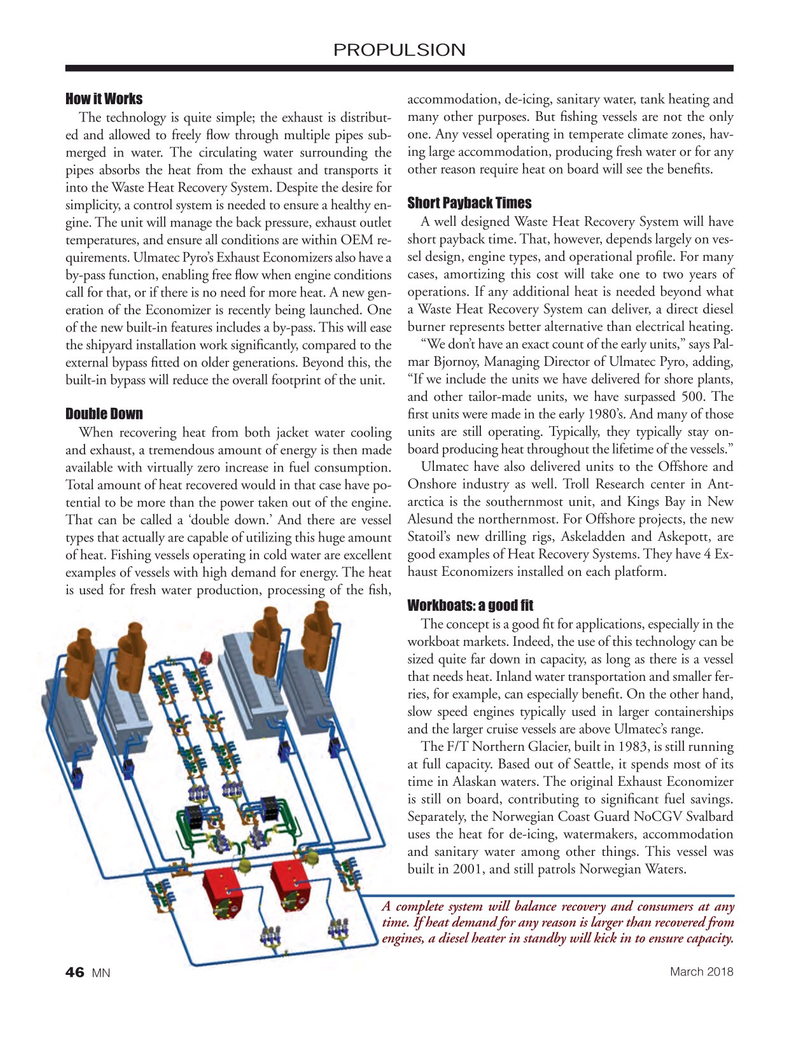
Page 46: of Marine News Magazine (March 2018)
Pushboats, Tugs & Assist Vessels
Read this page in Pdf, Flash or Html5 edition of March 2018 Marine News Magazine
PROPULSION
How it Works accommodation, de-icing, sanitary water, tank heating and
The technology is quite simple; the exhaust is distribut- many other purposes. But ? shing vessels are not the only ed and allowed to freely ? ow through multiple pipes sub- one. Any vessel operating in temperate climate zones, hav- merged in water. The circulating water surrounding the ing large accommodation, producing fresh water or for any pipes absorbs the heat from the exhaust and transports it other reason require heat on board will see the bene? ts.
into the Waste Heat Recovery System. Despite the desire for simplicity, a control system is needed to ensure a healthy en- Short Payback Times gine. The unit will manage the back pressure, exhaust outlet A well designed Waste Heat Recovery System will have temperatures, and ensure all conditions are within OEM re- short payback time. That, however, depends largely on ves- quirements. Ulmatec Pyro’s Exhaust Economizers also have a sel design, engine types, and operational pro? le. For many by-pass function, enabling free ? ow when engine conditions cases, amortizing this cost will take one to two years of call for that, or if there is no need for more heat. A new gen- operations. If any additional heat is needed beyond what eration of the Economizer is recently being launched. One a Waste Heat Recovery System can deliver, a direct diesel of the new built-in features includes a by-pass. This will ease burner represents better alternative than electrical heating.
the shipyard installation work signi? cantly, compared to the “We don’t have an exact count of the early units,” says Pal- external bypass ? tted on older generations. Beyond this, the mar Bjornoy, Managing Director of Ulmatec Pyro, adding, built-in bypass will reduce the overall footprint of the unit. “If we include the units we have delivered for shore plants, and other tailor-made units, we have surpassed 500. The
Double Down ? rst units were made in the early 1980’s. And many of those
When recovering heat from both jacket water cooling units are still operating. Typically, they typically stay on- and exhaust, a tremendous amount of energy is then made board producing heat throughout the lifetime of the vessels.” available with virtually zero increase in fuel consumption. Ulmatec have also delivered units to the Offshore and
Total amount of heat recovered would in that case have po- Onshore industry as well. Troll Research center in Ant- tential to be more than the power taken out of the engine. arctica is the southernmost unit, and Kings Bay in New
That can be called a ‘double down.’ And there are vessel Alesund the northernmost. For Offshore projects, the new types that actually are capable of utilizing this huge amount Statoil’s new drilling rigs, Askeladden and Askepott, are of heat. Fishing vessels operating in cold water are excellent good examples of Heat Recovery Systems. They have 4 Ex- examples of vessels with high demand for energy. The heat haust Economizers installed on each platform.
is used for fresh water production, processing of the ? sh,
Workboats: a good ? t
The concept is a good ? t for applications, especially in the workboat markets. Indeed, the use of this technology can be sized quite far down in capacity, as long as there is a vessel that needs heat. Inland water transportation and smaller fer- ries, for example, can especially bene? t. On the other hand, slow speed engines typically used in larger containerships and the larger cruise vessels are above Ulmatec’s range.
The F/T Northern Glacier, built in 1983, is still running at full capacity. Based out of Seattle, it spends most of its time in Alaskan waters. The original Exhaust Economizer is still on board, contributing to signi? cant fuel savings.
Separately, the Norwegian Coast Guard NoCGV Svalbard uses the heat for de-icing, watermakers, accommodation and sanitary water among other things. This vessel was built in 2001, and still patrols Norwegian Waters.
A complete system will balance recovery and consumers at any time. If heat demand for any reason is larger than recovered from engines, a diesel heater in standby will kick in to ensure capacity.
March 2018 46 MN
MN March18 Layout 32-49.indd 46 MN March18 Layout 32-49.indd 46 2/26/2018 9:15:12 AM2/26/2018 9:15:12 AM

 45
45

 47
47
